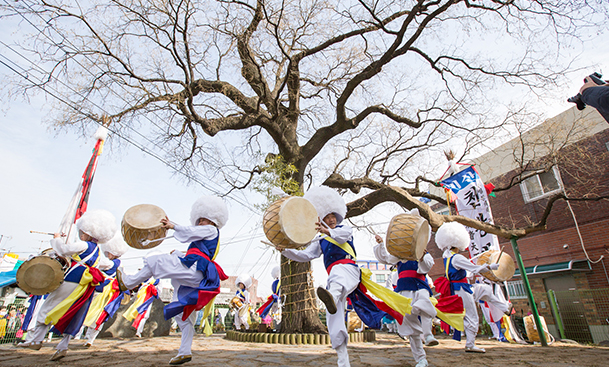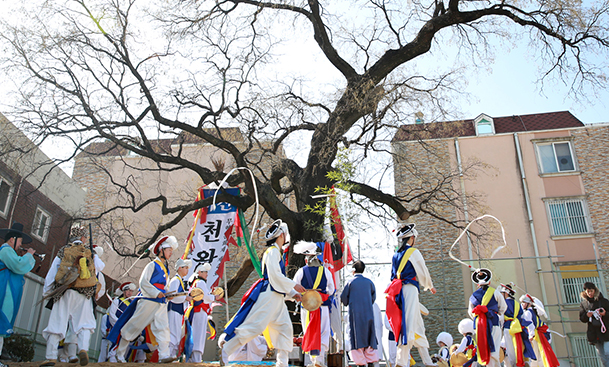Chunwang Mae-Gi
-
No.4 intangible cultural property designated by Daegu-si
Chunwang Mae-Gi
-
Artisan
Sugi KimDate of Designation
Jun.15.1989Training Center
48-144, Ihyeon-dong, Seo-gu, Daegu
Background and Origin
Chunwang Mae-gi is the Jishin Puli for King Gichun, King Jungchun, and King Malchun that Bisan-dong residents has been praying for a long time. There is a big old tree for King Gichun in Bisan Crossroad and a big old tree for King Malchun in Samsung Wedding Hall at Bisan 3-dong. King Jungchun is located in the location of Bisan 1-dong 1-beonji. For the worship for the king, old tree, shrine, and mountains are paired in groups. Inside the shrine, there is a drawing of Chunwang (King of Sky). However, the shrines and mountains were torn down in the process of urban development after 1960s.
Chungwang Mae-Gi is the Jishin Puli which has been performed before the Korean War. According to the oral tradition, about 400 years ago, many people suffered from continuous drought and plague in Daegu and the public sentiment got worsened. Then, the village residents built a shrine with soils at the place of King Jungchun and prayed devoutly. While passing the shrine, the residents threw a stone. The accumulated stones created small stone mountain and the residents regarded throwing the stone to the stone mountain as the prayer for Chunwang.
Every early January, the residents cleaned their body and mind and wore fine clothing to hold rites for Chunwang. They put pork head, alcohol, and rice cake on the altar and held up the Chunwang flag. It is said that the residents suffered from drought and diseases again when the prayer was insufficient. During the Japanese colonial area, the Japanese forces dug the place to make an emergency bunker and tremendous amount of brass coins were found in the place.
While general Jishin Balgi are performed at every door, Chungwang Mae-gi has the unique characteristic of ‘Village Gut’. Chunwang Mae-gi is performed in the process of Daenaerim Selection of Participants (in early January) Jil Gut Mun Gut Reading written prayer Chunwang Mae-gi Village Gut. In the process, Village Gut is for the Nongak while Mun Gut and Chunwang Mae-Gi is for Jishin Puli. Also, reading the written prayer is performed in a pure Confucian style. When assuming that Chunwang Mae-Gi has a Buddhist name, it would be considered as the dance and music combined with shamanism, Buddhism, and Confucianism.
Chunwang Mae-Gi once disappeared after the Korean War. In October 1988, the member of cultural heritage committee, Taekyu Kim and Youngchul Kwon excavated Chunwang Mae-Gi. Then, Daegu-si participated in the 29th National Folk Art Contest and got award from the Minister of Culture and Tourism. In June 15, 1989, Chunwang-Mae-Gi was designated as No.4 intangible cultural property of Daegu and it is well-preserved until now.
Key Awards and Events
- Aug.02.1978 Learned Kkwenggwari rhythm from the leading gong player of Daegu Bisan Nongak Group, Mungu Kim
- Jun.15.1982 Learned drum from Nalmoe Drum Dance performer, Subae Kim
- Oct.23.1983 Performed Nalmoe Drum Dance at 24th National Folk Art Contest (Got award from Minister of Culture and Tourism)
- Oct.22.1984 Performed Chunwang-Maegi at 25th National Folk Art Contest (Got participation award)
- Jun.15.1989 Designated the artisan for Bisan Chunwang Mae-Gi as No.4 intangible cultural property of Daegu
- Feb.19.1994 Completed graduate school of business administration at Yeungnam University
- Jan.01.1995 Served as the local chairman for the Federation of Artistic & Cultural Organization of Korea, Daegu Branch (Jan.01.1995~Dec.31.2001)
- Jul.01.1996 Got citation award from mayor of Daegu
- May.03.1997 Performed at the ceremony for sisterhood agreement between Hiroshima and Daegu
- Oct.18.1997 Performed Bisan Nongak at 38th National Folk Art Contest (Got award from Minister of Culture, Sports and Tourism)
- Nov.12.1997 Got 11th Geumbok Culture Award from Geumbok Cultural Foundation
- Oct.06.1999 Sent Daegu Cultural Mission to outdoor theater of Safari Park, Kenya, Afrca
- Aug.2004 Served as the first president of Daegu Intangible Cultural Property Association
- Oct.20.2004 Got the 24th Daegu Cultural Art Award
- Oct.20.2009 Published autobiography of Korean classical musician, Sugi Kim who devoted his life for Kkwenggwari
- Artisan and preserver of Chunwang Mae-Gi, No.4 intangible cultural property of Daegu
Performers
50 (Person reading written prayer, gong, drum, janggu, leader with flag, sogo, lord, wife, gunner, pole holder, Taepyeongso)
Performance Time
60 minutes
Performance Process
| Title | Content |
|---|---|
| ① Jil Gut | A Gut where all Paerengi group play while moving to the door of Chunwang-dang for Dangsan Ritual. While performing Jil Gut, the performers can let the whole village know that the Dangsan Ritual will be held. |
| ② Mun Gut | When performers arrive at the door of Chunwang-dang, they make cheerful atmosphere with Dadureki rhythm. Then, the performers beat off all bad lucks and wishes for great fortune of the year with Mun Gut. |
| ③ Uper Bbaegi | Composed of fast Jajinmori beat. The movement of sitting and jumping over are repeated. The part expresses the principle of yin and yang and shows manly and active dances. |
| ④ Chunwang Ritual | Composed of fast Jajinmori beat. The movement of sitting and jumping over are repeated. The part expresses the principle of yin and yang and shows manly and active dances. |
| ⑤ Chunwang Mae-Gi Gut | The performers express courtesy to all gods of mountain, water, and trees along the cheerful salpuri rhythm and perform Chunwang Mae-Gi Gut wishing for the peace in the town. |
| ⑥ Chunwang Mae-Gi Jishin Puli | Refers to the Jishin Puli for Chunwang-dang. The performer reads various written prayer for dispelling all pains, diseases, and bad lucks. |
| ⑦ Chunwang Gut | Cheerful performance held in front of Chunwang-dang after Jishin Puli. It is called Chunwang Gut as it is performed at Chunwang-dang. |
| ⑧ Chunwang Noli | Gut performed in front of King Gichun and King Malchun after Jishin Puli and Chunwang Gut. |
| ⑨ Village Gut | Village Gut for the village people after Gut for three kings. Village Gut is performed in the order of Jeongjuk Gunggi, Banjit Gut, Uper Bbaegi, Dadureki, Ganggangsulae, Huhu Gut, Obangjin, Modeum Gut Salpuri, Individual Play, and Dutbaegi. |
Details
| Classification | Content |
|---|---|
| Item | No.4 intangible cultural property of Daegu |
| Name | Chunwang Mae-Gi(Mae-Gi for Heavenly King) |
| Category | Intangible property / Traditional performance / Play / Saesi play |
| Date of Designation (Registration) | Jun.15.1989 |
| Location | 403, Dangsan-ro, Seo-gu, Daegu (Ihyeon-dong) |
| Person in Charge (Institute in Charge) | Sugi Kim |
| Inquiry | Cultural Information Division, Seo-gu, Daegu (+82-53-663-2184) |
Bisan Nongak is a farmer’s music originating from Bisan-dong called Nalmoe. The Nongak is assumed to have basis on Jisin Puli performed together with Chunwang Mae-Gi Gut held during the 15th of the January in Chunwang-dang (Gichun-dang, Jungchun-dang, Malchun-dang) worshipped by the residents from the far back in the past.
There is also a folk tale that Bisan Nongak was performed not only in Chunwang Mae-Gi or Jishin Puli but also in Wongogae during the visit of the local governor. Therefore, Bisan Nongak has the characteristics of Gunsa Gut rather than Nongsa (Agriculture) Gut. Although Bisan Nongak is composed of 12 parts, during the heyday of Bisan Nongak, the parts could be extended and people enjoyed the music for a long time.
In accordance to the record, there were shrines for King Gichun, King Jungchun, and King Malchun before the Korean War. The shrine for King Gichun was near the Wongogae market in Bisan 1-dong, Seo-gu while the shrine for King Jungchun was near the former Indongchon Market in Bisan 1-dong. Also, the shrine for King Malchun was near the present Samsung Wedding Hall (Bisan 2-dong, Bisan 3-dong). Before the Korean War, people performed rites in the shrines. After finishing the rites, people had a pleasant time with Bisan Nongak.
However, due the urban development in 1965, all shrines were torn down. In 1988, Daegu-si started excavation work for Chunwang-dang and got grand prize from National Folk Art Contest held in 1989. In June 15, 1989, the Chunwang-dang was designated as the intangible cultural property of Daegu.
In Dalseong-gun, there is the Chunwang-dang keeping its original form and the drawings of King Chunwang can be found inside Chunwang-dang.


